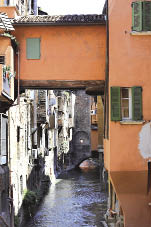|
Not only towers: Bologna – thanks to the
quantity, the length, the size and the beauty of those existing
structures in its secret bowels, which are aptly defined as
“underground urban architecture” – can
legitimately be named of the most important and fascinating
underground city in the world.
We are not referring so much
and only to the complex and intricate network of canals,
channels, drains, conduits, culverts, gates and other structures
built over the centuries for the water supply of the city, as to
the historical and archaeological heritage consisting of
artifacts made along the banks of the Aposa, the only natural
water course which runs through the city since its beginning,
from it source on the hill of Roncrio and downstream into the
Moline canal and into the mouth of Navile in Via Bovi Campeggi,
where once was the ancient port Maccagnano.
This long journey
- once known only in the stretches where it ran in the open sky -
can today be visited and in part accessible, even its underground
path, in the sections located between the two accesses of Piazza
Minghetti and Piazza San Martino. Every year tens of thousands of
Italian and foreign visitors take advantage of guided tours for
an adventure in the “underground history" of the city.
It is a story in which the Aposa was a witness to many and
sometimes gory events and happenings, the theater of escapes,
clandestine introductions, trades of smuggled goods, and even
more or less successful thefts.
Many historians and scholars,
over time, have written richly documented re-enactments and
reconstructions of events and historical and urban realities. But
no one, so far, had provided the opportunity to learn about the
Aposa visually step by step as it is done today, along its entire
course, including the stretches forbidden to "non-experts".
Now
they are providing a "millimeter", an evocative
instrument of knowledge of the course of the torrent, two members
of the praiseworthy Association "Friends of the waterways
and groundwater bodies of Bologna": Massimo Brunelli, with
his photos, and Angelo Zanotti with the very accurate essay in a
book aptly titled Il torrente sconosciuto svelato (The
unknown creek revealed), which allows one to add valuable
information to the study of the complex history of the water
system in Bologna.
|

|
|
The
course of the Aposa, rich in history, legends and fascination,
used 2,200 years ago by the Romans as a city landmark and as a
defensive moat of the same, was also used during the Second World
War, when the tunnels and underground environments along its
course were used to accommodate refuges for civilians and
soldiers, shelters, military commands, often made out from the
ancient structures.
Massimo Brunelli and Francisco Giordano
have dedicated themselves with passion and professionalism to
identify and describe with precision these shelters, especially
those intended for underground air-raid shelters, near the hill
of San Michele in Bosco, for the use of the Rizzoli Orthopaedic
Institute and the other for the adjacent military area.
In
both refuges (visits by appointment), it is among other things
possible to see the foundations on which rested the slab of wood
above the flowing water used as a floor for the refugees.
Not
along the Aposa, but still adapting an underground waterway in
the city is the Cavaticcio canal today in the Marconi area –
where had been set up the tragic shelter, able to accommodate
2,800 people, which was hit on September 25, 1943, during the
first foray on Bologna and thus turned out to be a terrible trap
where hundreds of people died: a plaque on Via Leopardi
commemorates that tragic day.
As the flowing water of the
stream, the centuries go by, and history is made: the Aposa
(according to legend, the name was given to the river by the
Etruscan king Fero, in memory of his beloved, of Gallic origin,
who crossed the waters to reach him and drowned) thus appears to
be "inextricably linked" to the city - as stated
Antonio de Capoa, lawyer and president of the "Friends of
the waterways and groundwater bodies of Bologna" - in a
positive and protective sense as though it were a tutelary deity.
|


|


